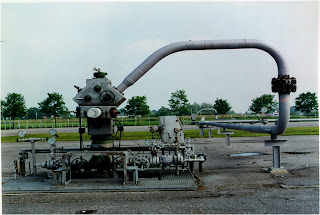Tubing Hanger/Xmas Tree Interface
Adapter Flange
•Cross-over between tubing hanger spool and x-mas tree
•It can receive the extended tubing hanger neck
•Feed through for:
– electrical cables (ESP or sensors)
– hydraulic controllines (sc-sssv)
–sensor lines etc
Surface Wellhead Connectors
Xmas Trees
Primary flow control system for well once in production
Features and access requirements
•Outflow from well - production
•Inflow to well - injection or killing
•Vertical access to tubing - wire line, coiled tubing
Flanged Xmas Tree
Xmas Tree Components
•Pressure gauges (accessory)
– safety hazard / potential wrong pressure readings
•Gauge flange or tree cap
–provides seal for top of tree
•Lubricator valve
–isolate pressure, well access for intervention tools
•Flow tee
–used to direct flow, enable thru-tubing access
•Production wing valve
–used to isolate well for most routine operations
•Kill wing valve
–enables connection of pumping equipment
•Choke (accessory)
–controls rate of flow from well
•Master valves (main isolation valves)
–Upper Master Valve (operational valve), optional: hydraulic / pneumatic controlled
Surface Safety Valve
Surface Safety Valve
–Lower Master Valve (back-up valve)
manually operated
X-mas tree valve
¥The stem rotates
¥The gate moves up and down
Choke
Categories of Xmas Tree
Flanged tree
•Several flanged components
– each connection is a potential leak path
•Much more common than monoblock design
•More flexible than monoblock design
•takes up more space (height)
Monoblock construction tree
•Single block construction
•Fewer possible leak paths
•Used in high pressure/leak sensitive locations
Comprises inline or "Y" shaped block of single casting/forging
Valving arrangement
•Lower Master Valve (manual)
•Upper Master Valve (Surface Safety Valve)
•Y piece or side outlet flanges
–houses both production and kill wing valves
•Uppermost valve (manual swab valve)
Tree hook-up
Multiple Completions
Cases where more than one completion string installed
•Each string independently suspended
•Must seal off tubing casing annulus
–either independently or collectively
•Independent control of fluid flow in each string
Multiple Completion Tree
Xmas Tree Selection
produce a listing of the parameters of the anticipated process or
operating envelope
- Classify the Well Type
Water Well ( low or medium pressure, Rate )
Oil Well (low, medium or high pressure, GOR, Rate )
Gas Well ( low, medium or high pressure, WGR, Rate)
This will be the basis for the design and the selection of equipment
type and rating
KEYWORDS
•tubing suspension
•annulus access
•hanger flange
•boll weevil
•ram type
•LMG, UMG, Swab valve
•production and kill wing valve
•surface safety valve
•flanged and monoblock tree
•pressure rating























